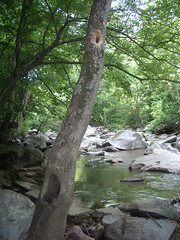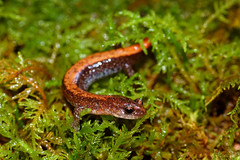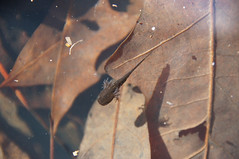Plants and Animals
Learn More
Other Websites
Explore this page
Plants
Plants living in the Tuliptree Small-Stream Floodplain Forest must be able to withstand occasional flooding. Ecobit: Rich But Hard To Live With Even tuliptree, which doesn’t tolerate waterlogged soil, is found here wherever drainage is better. The surface soil and fallen leaves in this natural community get moved around a lot with floodwaters, leaving some places "scoured" (denuded of fallen leaves and any especially shallow-rooted plants), and some places piled high with leaves and logs. Still other places get a fresh layer of silt, loaded with new seeds and other plant parts from upstream—some desirable, some not. As a result, this community can have a weedy look to the field layer, but it can also have shifting populations of beautiful spring wildflowers like Virginia bluebells.
Canopy Trees
The trees whose crowns intercept most of the sunlight in a forest stand. The uppermost layer of a forest.
- American elm
- American sycamore
- box-elder
- green ash
- river birch
- tuliptree
- bitternut hickory (occasional)
- black cherry (occasional)
- black walnut (occasional)
- mockernut hickory (occasional)
- pignut hickory (occasional)
- silver maple (occasional)
- swamp chestnut oak (occasional)
- white ash (occasional)
- white oak (occasional)
The Tuliptree Small-Stream Floodplain Forest at Rock Creek Park is primarily populated by deciduous hardwood trees suited to grow in sometimes-flooded or saturated soils. You can expect to see some combination of big American sycamore with green-and-white mottled bark, slender river birch with its rusty brown peeling bark, box-elder with its many-parted leaves (some of which resemble eastern poison-ivy), the diamond-shaped patterns of green ash bark, and the elegantly sweeping branching of American elm. Tuliptree, though not tolerant of waterlogged soil, is also common here, found on better drained parts of the landscape along with an occasional white ash. Look for very slight elevational increases, but keep in mind that drainage patterns underground aren’t always visible to the observer.
Understory Trees
Small trees and young specimens of large trees growing beneath the canopy trees. Also called the subcanopy.
- American hornbeam
- box-elder
- green ash
- red maple
- flowering dogwood (occasional)
- hophornbeam (occasional)
- red mulberry (occasional)
- slippery elm (occasional)
Red maple, box-elder, and the graceful American hornbeam are not uncommon sights in the understory of this natural community.
Shrubs, Saplings, and Vines
Shrubs, juvenile trees and vines at the right height to give birds and others a perch up off the ground but below the trees.
- American bladdernut
- pawpaw
- eastern poison-ivy
- northern spicebush
- blackhaw
- Virginia creeper
- American hazelnut
- greenbriers (occasional)
- southern arrow-wood (occasional)
- white fringetree (occasional)
- wild grapes (occasional)
Shrubs can inhabit the rich, moist Tuliptree Small-Stream Floodplain Forest in abundance. Northern spicebush (with a lemony, spicy smell to its crushed leaves and berries) may be the most commonly found shrub.
Less common, but a floodplain-dweller because of its high nutrient demand, is the tall shrub American bladdernut. It flowers without much fanfare in spring; by summer, though, it develops showy, inflated papery seed capsules that dangle like pale Japanese lanterns (and rattle when shaken, in autumn). These capsules float, dispersing across the floodplain and downstream during floods.
Slender pawpaw is distinctive because of its long leaves with pointed tips and brown velvety leaf buds that crown each twig-tip like a delicate paintbrush. Mature pawpaw bears beautiful but rather foul-smelling maroon flowers in spring that attract specific pollinators—especially carrion flies. In fall, its sweet fruit attracts the likes of raccoons, squirrels, birds… and people.
White fringetree flies under the radar most of the year, except when it makes a big splash in spring with its burst of stringy white flowers.
Low Plants (Field Layer)
Plants growing low to the ground. This includes small shrubs and tree seedlings.
- broadleaf enchanter’s-nightshade
- Canadian wood-nettle
- Dutchman’s breeches
- Jack-in-the-pulpit
- jumpseed
- mayapple
- jewelweed
- small-spike false nettle
- swamp smartweed
- Virginia bluebells
- Virginia springbeauty
- white snakeroot
- yellow trout-lily
- Canadian clearweed (occasional)
- Christmas fern (occasional)
- eastern waterleaf (occasional)
- grasses (occasional)
- Canadian honewort (occasional)
- sedges (occasional)
- sensitive fern (occasional)
- skunk-cabbage (occasional)
- Solomon’s plume (occasional)
- violets (occasional)
- Virginia wildrye (occasional)
- white avens (occasional)
- wingstem (occasional)
Many kinds of herbs and grasses find ideal growing conditions in the Tuliptree Small-Stream Floodplain Forest’s diverse soils and varying sunlight levels. Look for a delicate show of beautiful native spring ephemerals—Virginia springbeauty, yellow trout-lily, Virginia bluebells, and Dutchman’s breeches, among others—on moist, fertile floodplain terraces before the trees leaf out in spring. Ecobit: Spring EphemeralsWhile these sun-loving native woodland flowers are up for only a short time, they can cover large patches of ground, or nearly entire floodplains. Look closely, though, because at Rock Creek Park many of these are tucked among thick carpets of a non-native invasive yellow-flowering plant called lesser celandine. A few skunk-cabbage plants can be found here and there along the creek in spring, disappearing by mid-summer. (Where skunk-cabbage is extensive, it may be part of another natural community, the Red Maple Seepage Swamp.)
Throughout the spring, summer, and fall, many other native herbs flourish in the Tuliptree Small-Stream Floodplain Forest. Several require high levels of nutrients that, at Rock Creek Park, only the floodplains generally afford. One such example is Canadian wood-nettle, a stinging plant best observed and not touched (ouch!—beware the hairs on its stem). It sends forth delicate little feathery clusters of tiny pale greenish-white flowers from near the base of each leaf from July to September—about the same time that jewelweed's orange flowers bloom, and Jack-in-the-pulpit displays its cluster of red berries.
Non-Native Invasive Plant Species
In early spring you will likely see brightly-colored yellow flowering plants carpeting portions of the floodplain. Read about lesser celandine* and other non-native invasive plants that threaten this natural community. (* indicates non-native)
Notable Variations
Along the edges of Rock Creek in the northern-most part of the park, you may see other plants that are not typical of the Tuliptree Small-Stream Floodplain Forest. If they occurred in big enough patches, they would be mapped as other natural communities. Here are some of them:
Find out why under Notable Variations on the Physical Setting page.
Animals
 Overhanging trees keep the creek water cool for its inhabitants.
Overhanging trees keep the creek water cool for its inhabitants.
Photographer: Ery Largay, courtesy of NatureServeIn the Tuliptree Small-Stream Floodplain Forest, trees and shrubs clinging to the banks provide shady areas in the creek for stream-dwellers. The water temperature under the overhanging trees is a few degrees cooler than the water in the sunny middle of the creek. Shaded areas are favorable habitat for fish and other aquatic organisms in summer.
Beavers’ presence along the creek is evidenced by unevenly cut trunks of downed trees, and saplings carved like sharpened pencils. Excessive beaver activity can alter the flow of the creek in certain areas. Scientists are studying the effects of their ponds and lodges on the trapping and release of sedimentation, and on stream bank erosion. Raccoons, muskrats, coyotes, and foxes look for food in the floodplain community and waters at Rock Creek. Dragonflies hunt for other insects to eat, and swallowtail butterflies flit along the stream banks, searching for flower nectar.
 Pileated woodpeckers (Dryocopus pileatus) will nest in dead trees, using existing hollows or creating their own.
Pileated woodpeckers (Dryocopus pileatus) will nest in dead trees, using existing hollows or creating their own.
Photographer: Lyle MadesonThe nests of wood ducks, pileated woodpeckers, squirrels, and other animals occupy high cavities of standing trees (dead or alive) alongside the creek. Barn swallows nest under bridges, and can be seen swooping through the air to catch insects mid-flight. The belted kingfisher—a shaggy-crested, white-collared bird—nests in a horizontal tunnel in the creek bank. It can sometimes be heard or seen diving into the middle of Rock Creek in search of a meal. The first indication of its presence is often its distinctive rattle call which can be heard along the quieter waters of Rock Creek, signifying that you have entered a kingfisher’s territory. Wood ducks with their young, and the less commonly seen red-shouldered hawks and black-crowned night herons forage up and down the creek in summer, while the occasional great blue heron stalks fish along the sand bars of the Tuliptree Small-Stream Floodplain Forest.
Turtles, several kinds of salamanders, toads, and frogs enjoy the cool, damp earth beneath leaf litter and decaying logs near streams during hot summers. The eastern box turtle (Terrapene carolina) can live 50 years or more!
The eastern box turtle (Terrapene carolina) can live 50 years or more!
Photographer: Matt Jones The eastern box turtle (a small land turtle) forages for slugs or worms, berries, wild grapes and grapeleaves, mushrooms, and other plants and animals. Plants become a greater part of the diet of mature eastern box turtles, whose growing appetites may outpace their ability to catch enough animal prey. Eastern painted turtles hibernate in streams, and might be seen in and near the water during spring and summer, feeding on similar food sources. Common snapping turtles, found on land or in the water, eat just about any plant or animal they can swallow.
 Redback salamander (Plethodon cinereus).
Redback salamander (Plethodon cinereus).
Photographer: Ben LoweAdult salamanders have a carnivorous diet, eating invertebrates found in the soil. Several species of salamander found at Rock Creek have neither lungs nor gills as adults, instead depending on the damp habitat of the Tuliptree Small-Stream Floodplain Forest to keep their oxygen- and carbon dioxide-permeable skin moist and able to respire. Their skin even allows some to "breathe" under water. Lungless salamanders at Rock Creek Park include the redback, dusky, two-lined, and northern red salamanders. Even salamanders with sac-like lungs (such as Rock Creek’s spotted salamanders) augment their oxygen intake through their skin. Therefore, many salamanders are more active in the cool humidity of night, though a rainy or cloudy day might bring them out. Frogs and toads inhabiting the Tuliptree Small-Stream Floodplain Forest include northern spring peepers, green frogs, wood frogs, bullfrogs, pickerel frogs, and eastern American toads.
 Feathery external gills help salamander nymphs absorb oxygen from water.
Feathery external gills help salamander nymphs absorb oxygen from water.
Photographer: Matt JonesWithin the Tuliptree Small-Stream Floodplain Forest are seasonal wetlands—essentially large puddles set far back from the creek, that last for a whole season or more. Autumn or spring rains, or even a flooding event can fill up these temporary pools that typically won’t dry up until summer. Seasonal wetlands are important habitat for some salamanders, frogs, and toads that lay their gelatinous eggs there. Eggs that neither dry out, nor get jostled by flowing water, may survive and hatch. Since seasonal wetlands are dry part of the year, they may be free of fish—would-be predators of amphibians’ eggs and young larvae. Eggs and larvae, however, are not always safe from other frogs, toads, and salamanders!



